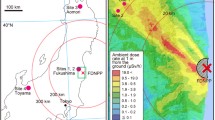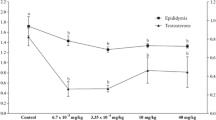Abstract
More than 20 years after Chernobyl nuclear power plant explosion, radionuclids are still mainly bound to the organic soil layers. The radiation exposure is dominated by the external exposure to gamma-radiation following the decay of 137Cs and by soil-to-plant-to-human transfer of 137Cs into the food chain. Because of this persistence of contamination with 137Cs, questions regarding public health for people living in contaminated areas were raised. We investigated the biological effects of chronic exposure to 137Cs on testicular and adrenal steroidogenesis metabolisms in rat. Animals were exposed to radionuclide in their drinking water for 9 months at a dose of 6,500 Bq/l (610 Bq/kg/day). Cesium contamination decreases the level of circulating 17β-estradiol, and increases corticosterone level. In testis, several nuclear receptors messenger expression is disrupted; levels of mRNA encoding Liver X receptor α (LXRα) and LXRβ are increased, whereas farnesoid X receptor mRNA presents a lower level. Adrenal metabolism presents a paradoxical decrease in cyp11a1 gene expression. In conclusion, our results show for the first time molecular and hormonal modifications in testicular and adrenal steroidogenic metabolism, induced by chronic contamination with low doses of 137Cs.



Similar content being viewed by others
Abbreviations
- CYP:
-
Cytochrome P450
- 137Cs:
-
Cesium 137
- hprt:
-
Hypoxanthine-guanine phosphoribosyltransferase
- FXR:
-
Farnesoid X receptor
- LXR:
-
Liver X receptor
- RXR:
-
Retinoid X receptor
- SHP:
-
Small heterodimeric partner
- StAR:
-
Steroidogenic acute regulatory protein
- 3β-HSD:
-
3 Beta hydroxysteroid dehydrogenase
- 17β-HSD:
-
17 Beta hydroxysteroid dehydrogenase
- SF-1:
-
Steroidogenic factor 1
- 5α-R1:
-
5 Alpha reductase type1
References
Bandazhevskaya GS, Nesterenko VB, Babenko VI, Yerkovich TV, Bandazhevsky YI (2004) Relationship between caesium (137Cs) load, cardiovascular symptoms, and source of food in ‘Chernobyl’ children—preliminary observations after intake of oral apple pectin. Swiss Med Wkly 134:725–729
Bandazhevsky YI (2003) Chronic Cs-137 incorporation in children’s organs. Swiss Med Wkly 133:488–490
Bezold G, Gottlober P, Gall H, Peter RU (2000) Accidental radiation exposure and azoospermia. J Androl 21:403–408
Carreau S, Bourguiba S, Lambard S, Galeraud-Denis I, Genissel C, Levallet J (2002) Reproductive system: aromatase and estrogens. Mol Cell Endocrinol 193:137–143
Cheburakov B, Cheburakov S, Belozerov N (2004) [Morphological changes in testicular tissue in clean-up personnel after the Chernobyl nuclear reactor accident]. Arkh Patol 66:19–21
Cherenko SM, Larin OS, Gorobeyko MB, Sichynava RM (2004) Clinical analysis of thyroid cancer in adult patients exposed to ionizing radiation due to the Chernobyl nuclear accident: 5-year comparative investigations based on the results of surgical treatment. World J Surg 28:1071–1074
Fiorucci S, Antonelli E, Rizzo G, Renga B, Mencarelli A, Riccardi L, Orlandi S, Pellicciari R, Morelli A (2004) The nuclear receptor SHP mediates inhibition of hepatic stellate cells by FXR and protects against liver fibrosis. Gastroenterology 127:1497–1512
Fischbein A, Zabludovsky N, Eltes F, Grischenko V, Bartoov B (1997) Ultramorphological sperm characteristics in the risk assessment of health effects after radiation exposure among salvage workers in Chernobyl. Environ Health Perspect 105(Suppl 6):1445–1449
Goncharov NP, Katsiya GV, Kolesnikova GS, Dobracheva GA, Todua TN, Vax VV, Giwercman A, Waites GM (1998) Endocrine and reproductive health status of men who had experienced short-term radiation exposure at Chernobyl. Int J Androl 21:271–276
Handl J, Beltz D, Botsch W, Harb S, Jakob D, Michel R, Romantschuk LD (2003) Evaluation of radioactive exposure from 137Cs in contaminated areas of Northern Ukraine. Health Phys 84:502–517
Ivanov VK, Maksioutov MA, Chekin S, Kruglova ZG, Petrov AV, Tsyb AF (2000) Radiation-epidemiological analysis of incidence of non-cancer diseases among the Chernobyl liquidators. Health Phys 78:495–501
Killian J, Pratis K, Clifton RJ, Stanton PG, Robertson DM, O’Donnell L (2003) 5-Alpha-reductase isoenzymes 1 and 2 in the rat testis during postnatal development. Biol Reprod 68:1711–1718
Kramer PR, Wray S (2002) 17-Beta-estradiol regulates expression of genes that function in macrophage activation and cholesterol homeostasis. J Steroid Biochem Mol Biol 81:203–216
Lundholm L, Moverare S, Steffensen KR, Nilsson M, Otsuki M, Ohlsson C, Gustafsson JA, Dahlman-Wright K (2004) Gene expression profiling identifies liver X receptor alpha as an estrogen-regulated gene in mouse adipose tissue. J Mol Endocrinol 32:879–892
Mamina VP (1998) [Histological analysis of the testis of Apodemus sylvaticus and Clethrionomys rutilus living in radioactively contaminated areas]. Radiats Biol Radioecol 38:813–818
Micevych PE, Chaban V, Ogi J, Dewing P, Lu JK, Sinchak K (2007) Estradiol stimulates progesterone synthesis in hypothalamic astrocyte cultures. Endocrinology 148:782–789
Morita N, Takamura N, Ashizawa K, Shimasaki T, Yamashita S, Okumura Y (2005) Measurement of the whole-body 137Cs in residents around the Chernobyl nuclear power plant. Radiat Prot Dosimetry 113:326–329
Pomerantseva MD, Ramaiya LK, Chekhovich AV (1997) Genetic disorders in house mouse germ cells after the Chernobyl catastrophe. Mutat Res 381:97–103
Ropenga A, Chapel A, Vandamme M, Griffiths NM (2004) Use of reference gene expression in rat distal colon after radiation exposure: a caveat. Radiat Res 161:597–602
Souidi M, Gueguen Y, Linard C, Dudoignon N, Grison S, Baudelin C, Marquette C, Gourmelon P, Aigueperse J, Dublineau I (2005) In vivo effects of chronic contamination with depleted uranium on CYP3A and associated nuclear receptors PXR and CAR in the rat. Toxicology 214:113–122
Souidi M, Tissandie E, Grandcolas L, Grison S, Paquet F, Voisin P, Aigueperse J, Gourmelon P, Gueguen Y (2006) Chronic contamination with 137cesium in rat: effect on liver cholesterol metabolism. Int J Toxicol 25:493–497
Tissandie E, Gueguen Y, Lobaccaro JM, Grandcolas L, Voisin P, Aigueperse J, Gourmelon P, Souidi M (2007) In vivo effects of chronic contamination with depleted uranium on vitamin D3 metabolism in rat. Biochim Biophys Acta 1770:266–272
Volle DH, Duggavathi R, Magnier BC, Houten SM, Cummins CL, Lobaccaro JM, Verhoeven G, Schoonjans K, Auwerx J (2007a) The small heterodimer partner is a gonadal gatekeeper of sexual maturation in male mice. Genes Dev 21:303–315
Volle DH, Mouzat K, Duggavathi R, Siddeek B, Dechelotte P, Sion B, Veyssiere G, Benahmed M, Lobaccaro JM (2007b) Multiple roles of the nuclear receptors for oxysterols LXR to maintain male fertility. Mol Endocrinol
Vykhovanets EV, Chernyshov VP, Slukvin II, Antipkin YG, Vasyuk A, Colos V (2000) Analysis of blood lymphocyte subsets in children living around Chernobyl exposed long-term to low doses of cesium-137 and various doses of iodine-131. Radiat Res 153:760–772
Acknowledgments
The authors thank T. Loiseau, F. Voyer, and C. Baudelin for their assistance during animal exposure and experimentation. This study was part of the ENVIRHOM research program supported by the Institute for Radioprotection and Nuclear Safety (IRSN). JMAL is supported by the CNRS, Université Blaise Pascal, Fondation BNP-Paribas and Fondation pour la Recherche Médicale.
Author information
Authors and Affiliations
Corresponding author
Rights and permissions
About this article
Cite this article
Grignard, E., Guéguen, Y., Grison, S. et al. In vivo effects of chronic contamination with 137 cesium on testicular and adrenal steroidogenesis. Arch Toxicol 82, 583–589 (2008). https://doi.org/10.1007/s00204-007-0268-4
Received:
Accepted:
Published:
Issue Date:
DOI: https://doi.org/10.1007/s00204-007-0268-4




